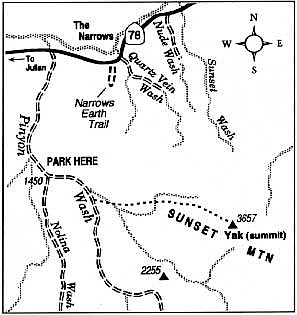 Facebook
Facebook
 X
X
 Instagram
Instagram
 TikTok
TikTok
 Youtube
Youtube
Sunset Mountain stands lofty and somewhat isolated from the main ridge of the Vallecito Mountains in the center of Anza-Borrego Desert State Park. As seen from Borrego Springs and other far points to the west, the desert-varnished rocks on its flank glow warmly in the evening light. Presumably the mountain glows as the sun is rising, too, as seen from points east of it.
Hikers can climb Sunset Mountain most easily from the west. First, you need to obtain an Anza-Borrego parking pass ($5 daily, $10 for three days), available at any campground and at various roadside locations within the park. Then drive out to the starting point: In an ordinary (but not low-slung) passenger car, turn south off of Highway 78 at mile marker 81.0 (about 22 miles east of Julian) and onto the road marked Pinyon Wash. Proceed 1.6 miles on hard-packed sand to the intersection of Nolina Wash. Park your car in a place that is not blocking the road and is not on sand so soft that you'll get stuck. (Past this point you may be able to travel farther up Pinyon Wash in a four-wheel-drive vehicle, but not in a two-wheel-drive vehicle.)
From the Nolina Wash intersection the mostly trailless hike measures three miles out and three miles back and involves an elevation change of 2200 feet. The whole journey should take a minimum of five hours -- not including any rest stops. Wear boots for ankle support and to help keep cactus spines out of your feet. Don't forget to bring plenty of water.
On foot, follow the Pinyon Wash road east and southeast for less than a mile. After going that far, the entire west slope of Sunset Mountain is in view, and you can picture one or more routes to the top. Get off the road, cross the small bajada (gently tilted slope) at the base of the mountain, and begin the ascent route of your choice. It will be an arduous climb -- an elevation gain of almost 2000 feet over sun-blasted boulders, loose pebbles, and sinister patches of agave and cactus. The view from the top is worth the trouble, especially on clear winter days. The Salton Sea to the east is striking, with its surface mirroring the blue sky.
Take care on the way back down the mountain. The task of keeping your balance and avoiding a tumble into a bed of rocks and spines will be more challenging as you head downhill.


Sunset Mountain stands lofty and somewhat isolated from the main ridge of the Vallecito Mountains in the center of Anza-Borrego Desert State Park. As seen from Borrego Springs and other far points to the west, the desert-varnished rocks on its flank glow warmly in the evening light. Presumably the mountain glows as the sun is rising, too, as seen from points east of it.
Hikers can climb Sunset Mountain most easily from the west. First, you need to obtain an Anza-Borrego parking pass ($5 daily, $10 for three days), available at any campground and at various roadside locations within the park. Then drive out to the starting point: In an ordinary (but not low-slung) passenger car, turn south off of Highway 78 at mile marker 81.0 (about 22 miles east of Julian) and onto the road marked Pinyon Wash. Proceed 1.6 miles on hard-packed sand to the intersection of Nolina Wash. Park your car in a place that is not blocking the road and is not on sand so soft that you'll get stuck. (Past this point you may be able to travel farther up Pinyon Wash in a four-wheel-drive vehicle, but not in a two-wheel-drive vehicle.)
From the Nolina Wash intersection the mostly trailless hike measures three miles out and three miles back and involves an elevation change of 2200 feet. The whole journey should take a minimum of five hours -- not including any rest stops. Wear boots for ankle support and to help keep cactus spines out of your feet. Don't forget to bring plenty of water.
On foot, follow the Pinyon Wash road east and southeast for less than a mile. After going that far, the entire west slope of Sunset Mountain is in view, and you can picture one or more routes to the top. Get off the road, cross the small bajada (gently tilted slope) at the base of the mountain, and begin the ascent route of your choice. It will be an arduous climb -- an elevation gain of almost 2000 feet over sun-blasted boulders, loose pebbles, and sinister patches of agave and cactus. The view from the top is worth the trouble, especially on clear winter days. The Salton Sea to the east is striking, with its surface mirroring the blue sky.
Take care on the way back down the mountain. The task of keeping your balance and avoiding a tumble into a bed of rocks and spines will be more challenging as you head downhill.
